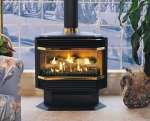Search engine visitors - click here to access entire "$ensible Home" web site
Click here to see a descriptive illustration showing photos of four new wood-burning stoves.
Dear Jim: We have a standard open fireplace, but I would like to also install a wood-burning stove. I have seen some attractive ornate ones with brass and gold trim. How do I go about selecting and sizing one? - Karl M.

A: Many of the new freestanding wood-burning stoves are not only very ornate, but they are efficient and clean-burning as well. If your house is more than 10 years old, many modern wood-burning stoves are more efficient (up to 83 percent) than your existing builder-installed furnace.
It is wise to consider an ornate stove because, with the comfort and ambiance of the fire, it will become the gathering place for family and guests. Decorative features, though, such as gold-plated doors and legs, large glass viewing door, and glossy finish can almost double the cost of some stoves.
Your first decision will be whether to get a cast iron or welded-steel stove. Both function equally well, but cast iron construction allows for much more intricate and ornate styling and surface detailing. Some steel stoves offer a cast iron door to jazz up the appearance. Cast iron is slightly more brittle than steel and generally more expensive.
Most manufacturers state a heat output and the size (in square feet) of the area one can heat. These are really just estimates and vary substantially based on many factors such as type of firewood, efficiency of house, climate, etc.
Determine how large an area you intend to heat and talk with several local stove shop professionals to get a consensus on the size required. Don't just buy a large, pretty one. If you install a stove that is too large, you will have to damp the fire down which lowers efficiency and increases pollution.
You have choices between a catalytic and noncatalytic design. A catalytic combustor is a device located at the flue outlet. It works similar to the catalytic converter in your car to reduce emissions into the air.
As the smoke and unburned volatile gases leave the firebox, the hot combustor ignites them. This extra combustion also increases the stove's heat output and efficiency. By burning the volatile gasses before they enter the chimney, there is less creosote buildup and less chance of a chimney fire.
A catalytic stove costs a couple of hundred dollars more than a standard stove. You must clean (you can do it yourself) a combustor annually. If you are going to use your stove often and you live in a residential area where smoke may annoy neighbors, a catalytic stove might be the best choice.
Since you have an open fireplace, another efficient option is a fireplace insert. It will have a blower to circulate the hot air throughout the area.
Instant Download Update Bulletin No. 777 - buyer's guide of 11 wood-burning stove/fireplace insert manufacturers listing combustion type (catalytic or noncatalytic), efficiency rate, estimated max. burn time, estimated room area size it will heat, heat output, features (comfort and styling), prices, and firewood selector chart.
Dear Jim: I am having new shingles put on my roof and they are going to tear off the two older layers. I was thinking of having a foil radiant barrier placed there instead of inside the attic. Will this work? - Mac K.
A: It is good the two layers of old shingles are being removed. Three layers of shingles would be too many. The foil should be put under the roof rafters inside of the attic, not over the roof before the shingles are applied.
The foil needs to have an open air gap beneath it to be effective at blocking summer heat from the roof. If it were placed underneath the shingles, its low-emissivity surface properties would not be effective.